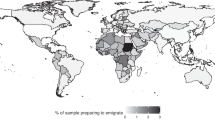Abstract
Very little prior research has been devoted to the effects of the institutional structure of local government on public sector labor markets. This study addresses the differential effects of the two main systems used to elect city council members — district versus citywide (at-large) elections. The study hypothesizes that, in district-election cities, municipal employees, especially those who are unionized, face a lower cost of influencing city council candidates and, consequently, will have greater power to influence employment conditions. To test this hypothesis, data on U.S. cities over 25,000 population are used to estimate both reduced form and structural wage and employment equations. The results are consistent with the basic hypothesis: district elections provide a more fertile ground for municipal employees, especially those organized in unions, to affect their employment conditions.
Similar content being viewed by others
References
Bennett, James, and William Orzechowski. “The Voting Behavior of Bureaucrats: Some Empirical Evidence.”Public Choice 41 (1983): 271–83.
Courant, Paul, Edward Gramlich, and Daniel Rubinfeld. “Public Employee Market Power and the Level of Government Spending.”American Economic Review 69 (December 1979): 806–17.
Dalenberg, Douglas R., and Kevin Duffy-Deno. “At-Large Versus Ward Elections: Implications for Public Infrastructure.”Public Choice 70 (June 1991): 335–42.
Deno, Kevin T., and Stephen L. Mehay. “Municipal Management Structure and Fiscal Performance: Do City Managers Make a Difference?”Southern Economic Journal 54 (January 1987): 627–42.
Dudley, Leonard, and Claude Montmarquette. “The Effects of Non-Clearing Labor Markets on the Demand for Public Spending.”Economic Inquiry 22 (April 1984): 151–70.
Farnham, Paul G. “Form of Government and the Median Voter.”Social Science Quarterly 68 (September 1987): 569–82.
Gonzalez, Rodolfo, Stephen Mehay, and Kevin Duffy-Deno. “Municipal Residency Laws: Effects on Police Employment, Compensation, and Productivity.”Journal of Labor Research 12 (Fall 1991): 439–52.
Hayes, Kathy, and Semoon Chang. “The Relative Efficiency of City Managers and Mayor-Council Forms of Government.”Southern Economic Journal 57 (July 1990): 167–77.
Hirsch, Werner, and Anthony Rufolo. “Economic Effect of Residence Laws on Municipal Police.”Journal of Urban Economics 17 (July 1985): 335–48.
Lineberry, Robert L., and Edmund P. Fowler. “Reformism and Public Policies in American Cities.”American Political Science Review 61 (September 1967): 701–16.
Kmenta, Jan.Elements of Econometrics. 2d ed. New York: Macmillan, 1986.
Lyons, William. “Reform and Response in American Cities: Structure and Policy Reconsidered.”Social Science Quarterly 59 (June 1978): 118–32.
___, and Malcolm Jewell. “Minority Representation and the Drawing of City Council Districts.”Urban Affairs Quarterly 23 (March 1988): 432–47.
Maddala, G. S.Introduction to Econometrics. 2d ed. New York: Macmillan, 1992.
Morgan, David R., and John P. Pelissero. “Urban Policy: Does Political Structure Matter?”American Political Science Review 74 (December 1980): 999–1006.
O’Brien, Kevin M. “Compensation, Employment, and the Political Activity of Public Employee Unions.”Journal of Labor Research 13 (Spring 1992): 189–204.
Reid, Gary J. “Tests of Institutional Versus Non-Institutional Models of Local Expenditure Determination.”Public Choice 70 (June 1991): 315–33.
Sanders, Heywood T. “The Government of American Cities,” in theMunicipal Yearbook, 1982. Washington, D.C.: International City Management Association, 1982.
Trejo, Stephen J. “Public Sector Unions and Municipal Employment.”Industrial and Labor Relations Review 45 (October 1991): 166–80.
U.S. Department of Commerce,Labor-Management Relations in State and Local Governments: 1980. Washington, D.C.: U.S. Government Printing Office, 1980.
Zax, Jeffrey S. “Reform City Councils and Municipal Employees.”Public Choice 64 (February 1990): 167–78.
Author information
Authors and Affiliations
Additional information
The authors acknowledge the helpful comments of Tim Sass, Tom Means, and participants in a session at the 1991 Public Choice Society meetings.
Rights and permissions
About this article
Cite this article
Mehay, S.L., Gonzalez, R.A. District elections and the power of municipal employee unions. Journal of Labor Research 15, 387–402 (1994). https://doi.org/10.1007/BF02685705
Issue Date:
DOI: https://doi.org/10.1007/BF02685705




